#you would not BELIEVE
Text

posing 101 by izuku midoriya
#you would not BELIEVE#the amount of dudebros#who got angry at me#for this#just wait till they find out#horikoshi drew this idea himself#bnha#mha#bunnyzuku#deku#izuku midoriya#ochako#uraraka ochacho#jirou#kyoka jiro#shouto todoroki#todoroki#mirko#mirkobnha#my art#olldolldrawsart
6K notes
·
View notes
Text
Misuta my beloved

(TAP IMAGE FOR HIGHER QUALITY)
Close-ups!


@venomous-qwille's Misuta <3
[ID written by @starryeyed-queer]
#dca fnaf#daycare attendant#fnaf moon#dca fandom#daycare attendant fnaf#icy art#dca moon#ghost in the machine au#daycare attendant moon#fnaf moondrop#misuta moon#this took me so long#you would not believe
241 notes
·
View notes
Text
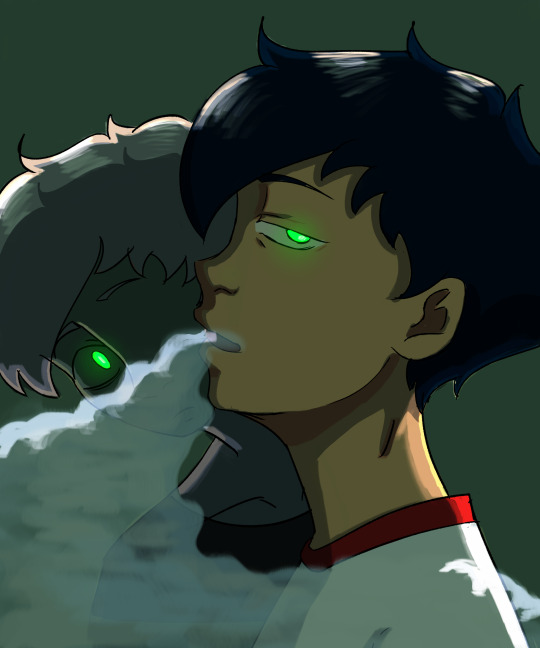
guys I think I like Danny Phantom 💚
inspired by this TikTok !
#you would not believe#the trials and tribulations#i had to go through#for this piece#for some reason#i forgot how to make#side profiles#???#like what#anyways#lol#danny phantom#danny fenton#danny phantom fanart#danny fenton fanart#phan art
107 notes
·
View notes
Text
my mom ships more in south park than i do
46 notes
·
View notes
Photo


Took awhile but I finished! The Empires season 2 height chart!
#empires smp#empiressmp#smallishbeans#solidarity gaming#mythical sausage#pixlriffs#falsesymmetry#smajor#katherine elizabeth#theorionsound#joey graceffa#geminitay#shubble#fwhip#ldshadowlady#this took so long#you would not believe#this is my headcanon too on their heights#100% not canon#anyways time to retire#<-- /j#sunnysmc
514 notes
·
View notes
Text

Legends of Fraldarius
(Click for Better Quality)
8/25/22
#Fire Emblem Three Houses#Fanart#Gentsmaarts#Art#3 Houses#fe3h#artists on tumblr#digital art#Painting#Fraldarius#The border took so many hours my guy#you would not believe#three hopes#gentsmaart
242 notes
·
View notes
Text
Happy birthday to Fireflies by Owl City
45 notes
·
View notes
Text

everybody today's been telling me I look like jesus
#me#beard#hair#had to wash it bc i was changing displays in the lighting cloud today#so fucking dusty#you would not believe
40 notes
·
View notes
Text
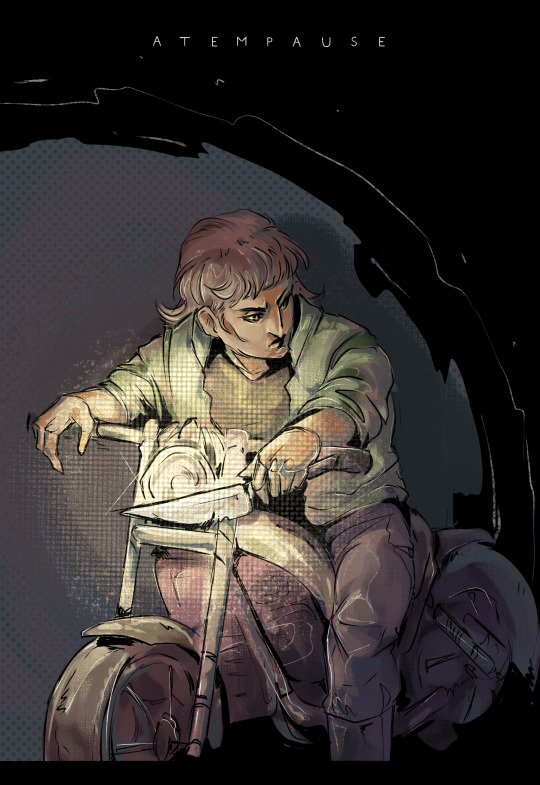
art fight revenge for @natythefanatic
#other people's ocs#art fight 2023#you would NOT BELIEVE#how much pain in the ass the dot brush is to use in firealpaca#but i like it i wanna use it more so rip
19 notes
·
View notes
Text

Six games in and someone’s finally grasped the concept of “conflict of interest”.
#Ace attorney: spirit of justice#nahyuta sahdmadhi#dhurke sahdmadhi#in America this shit would fly#wouldn’t even be a question#the shenanigans we’ve gotten up to before#you would not BELIEVE#but this is the first time someone’s been like#hey maybe not#queue takumi defense squad
36 notes
·
View notes
Text
the problem with the largest bead retailer in the world being 30 minutes from my mom’s house is i love to spend so much money there
#zoe stuff#you would not BELIEVE#their showroom has like 30 rows of shelves#just full of beads#and they have an entire warehouse across the street
15 notes
·
View notes
Text
Conservative adults are so fucking funny with wanting to gatekeep helpful and positive info about being queer from children when they were literally the ones insulting me commenting on what they thought my gender and sexuality were before I even knew what the fuck they were talking about. Like, mind your own fucking business?? People like that hurt me in a way that stays with you for your whole life. But, no, definitely ban that book with the two penguin dads or whatever
#my parents were just accepting and let me live#it was other adults who publicly and openly commented on what they thought my gender and sexuality were#same people who want to stop kids from learning about gender and sexuality#like ... fuck off.#queer#my gender and sexuality#is mine#not yours#you don't get a say in it#trans#pansexual#bisexual#genderfluid#nonbinary#gay#lesbian#as a queer person who has apparently always been visibly queer#the incredibly invasive fucked up things these conservative people would say to me when I was a child#you would not believe#or maybe you would
3 notes
·
View notes
Text
Given that the largest species of fireflies tend to reach about an inch long, and given that we provide them each one cubic inch of space (so they have room to hover/fly), i would indeed by quite shocked if i saw ten million fireflies, and 10,000,000 in^3 is about 5787 cubic feet of fireflies, forming a cube of fiery fly that is about 18 feet on each end, near two stories tall. indeed, if said fireflies were laid out in a flat plane, each taking up one square inch, that would be 69,444 square feet of firefly, which while 24 square feet more than being extremely funny, is still enough to cover about 1.2 football fields. truly a beautiful, yet terrifying experience.
8 notes
·
View notes
Text
it’s not enough to say “I think they should kiss” at this point, I’m on “I think they should eat each other”
#Actually having this thought abt multiple ships at all times#You would not believe#Also posts made by a guy who avoids cannibalism stories at all costs#But it’s my truth
6 notes
·
View notes
Text
The Shirakawa Yoshimi Shrine
I already got my preamble over in my last post, so there's no need for one here, let's get right into it!
Right after the visiting the Kamishikimi Kumanoimasu Shrine, we went to the nearby Shirakawa Spring (白川水源 lit. "white river water source").
So here's the shrine within the grounds of which the spring is found, the Shirakawa Yoshimi Shrine (白川吉見神社), located on the souther foot of Mount Aso.
Below: The entrance of the shrine, as marked by the two komainu statues and the shimenawa bound torii gate. From this website on the shrines of Kyushu.
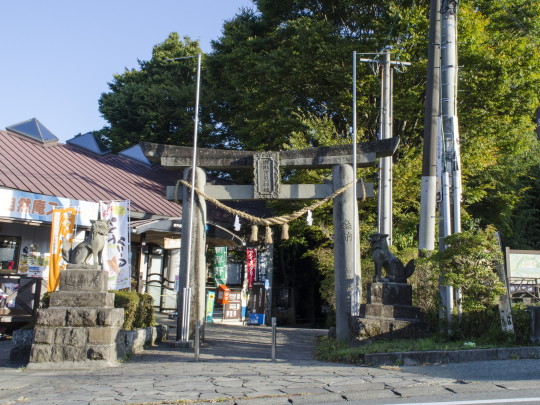
My visit to the shrine
Like I mentioned, we headed here right after leaving the Kamishikimi Kumanoimasu Shrine from my last post.
Unlike that shrine, this one's rather more famous (or rather, its spring is famous), and so has a car park located conveniently next to the shrine's entrance, as well as a gift shop selling local goods and souvenirs.
Below: My own image of the shrine's entrance.

As you could see, I only caught the un-shaped komainu statue, i.e. the one with its mouth closed, this was cause stand any further back and I'd be out on the car road. So instead:

Here's another one with the a-shaped komainu, i.e. the one with its mouth open. Together, they are said to form "Aum" (or perhaps more commonly "Om"), a sacred syllable in many religions, Buddhism included.
Anyways, we passed through the gate, we walked along the shrine road, which had a few souvenir shops and little rest houses as well, and even this little stall!

"Everything is 100 yen!!" It's an unmanned shop probably where local farmers leave their excess crops to sell, here we see bags of potatoes and eggplants.
Passing the shops and stands we move into an area where the trees part, coming face to face with a river. This is of course the eponymous Shirakawa (白川), "the white river".
Below: A section of Shirakawa I saw on the way to the spring.

Finally, we arrive at the shrine proper, passing by a toll gate. The shrine's been getting more and more visitors due to its fame, and so started collecting a modest fee of 100 yen per visitor (of high school age and above) for environmental conservation.
Before passing the second torii gate and going to the shrine building, we find a lowered platform that allows visitors to get near the river.
Below: The lowered area.
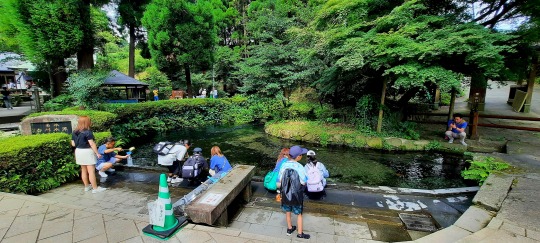
The tray on the left of the wooden bench has various funnels and ladles, allowing visitors to get their own bottle of pristine Shirakawa spring water. I myself took a sip of the water, and it was refreshing indeed~.
Notably, the river itself also serves as where visitors cleanse themselves before paying respects at the shrine. Shinto deities abhor defilement and impurities, thus it is customary to cleanse oneself, typically with water.
A good number of shrines have a fountain, called a chouzu-ya (手水舎 lit. "hand water pavilion"), where one is expected to wash their hands and mouth, to purify themself before meeting the shrine's god.
However, this shrine simply uses the natural spring water that flows from within shrine grounds. After all, why use the man-made when we have access to the gods' blessings directly?
(Do note though to be careful not to let water spill back into the river, and definitely do not spit water that's used to cleanse your mouth back into the river. The floor around will do.)
Below: The entrance of the shrine proper, pass the shrine road, from the same site previously mentioned.

Having cleansed myself, we go through the shrine's second torii gate and towards the shrine buildings. The engaku (on both gates actually) reads, plain and simple, "Shirakawa Yoshimi Shrine".
Below: The second torii of the shrine, pass it is the shrine proper.
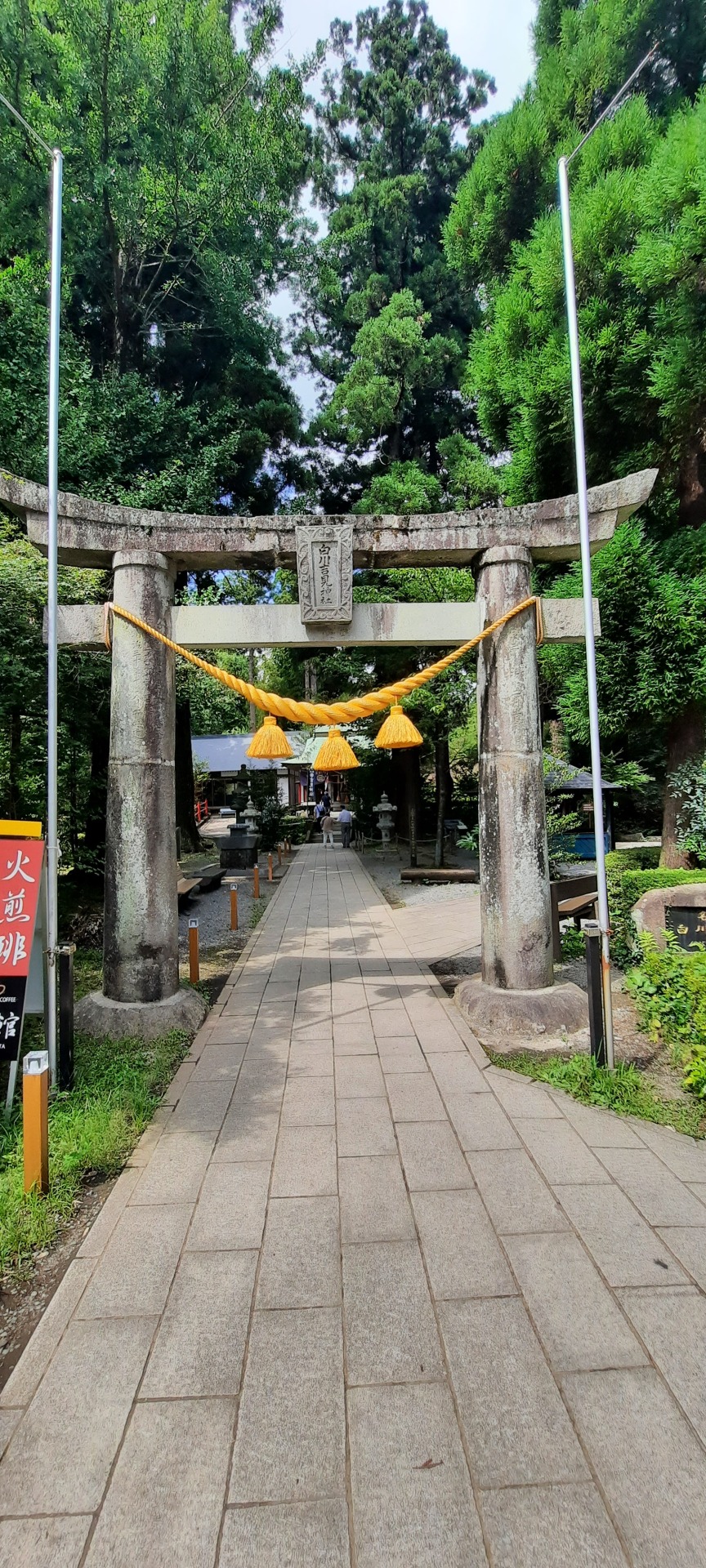
Right after we enter, on the left is a typical man-made chouzu-ya fountain, on which reads "seishin" (清心), "to purify one's heart" or simply "pure heart, which is how one should conduct themself before the gods.
Below: The shrine's proper chouzubachi, taken from the same site once again.

Of course, as you see from the image, it doesn't even have a ladle for you to get water from it. They really do expect visitors to cleanse themselves with the river, after all.
As you can see from the image of the torii gate, the road branches into two. We went on the right path first, which leads to the shrine's greatest treasure: The Shirakawa Spring.
However, before reaching the spring, we come across a small hokora (祠), a small-scale shrine where local folk deities are often enshrined. This particular one enshrines Suijin (水神 lit. "water god") the god of the spring.
Below: The roadside hokora.
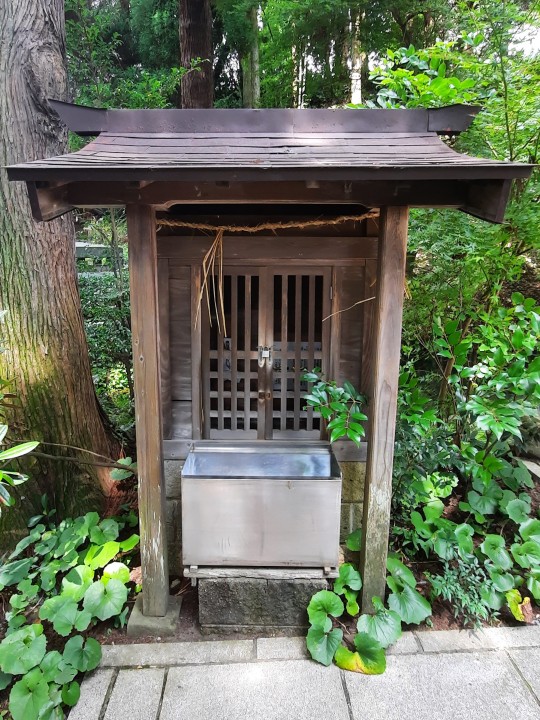
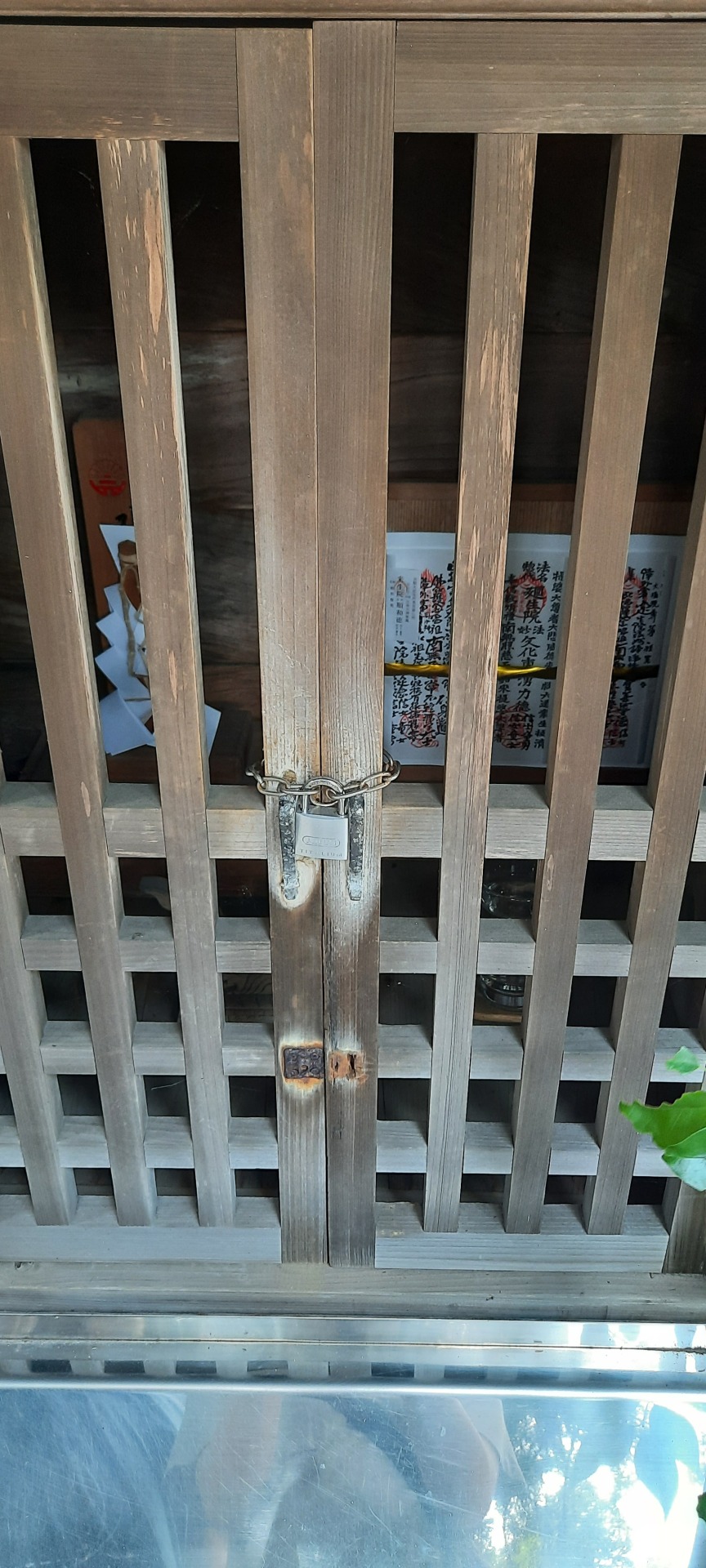
Anyways, passing the hokora by we reach the spring itself!
Below: The Shirakawa Spring.

The spot in the middle that's especially blue is where the water was gushing out from, and oh how clear the water was! And look at the moss growing on the river bed! It really was an awe-inspiring sight~.
Here's a video, which hopefully shows off how water gushes out from the riverbed (don't mind the cicadas lol it was prime cicada season).
After marvelling at the spring, I took a quick look the shrine buildings. Starting with: The prayer hall. The flags being displayed out front read "Yoshimi Shrine" (吉見神社).
Below: The prayer hall.
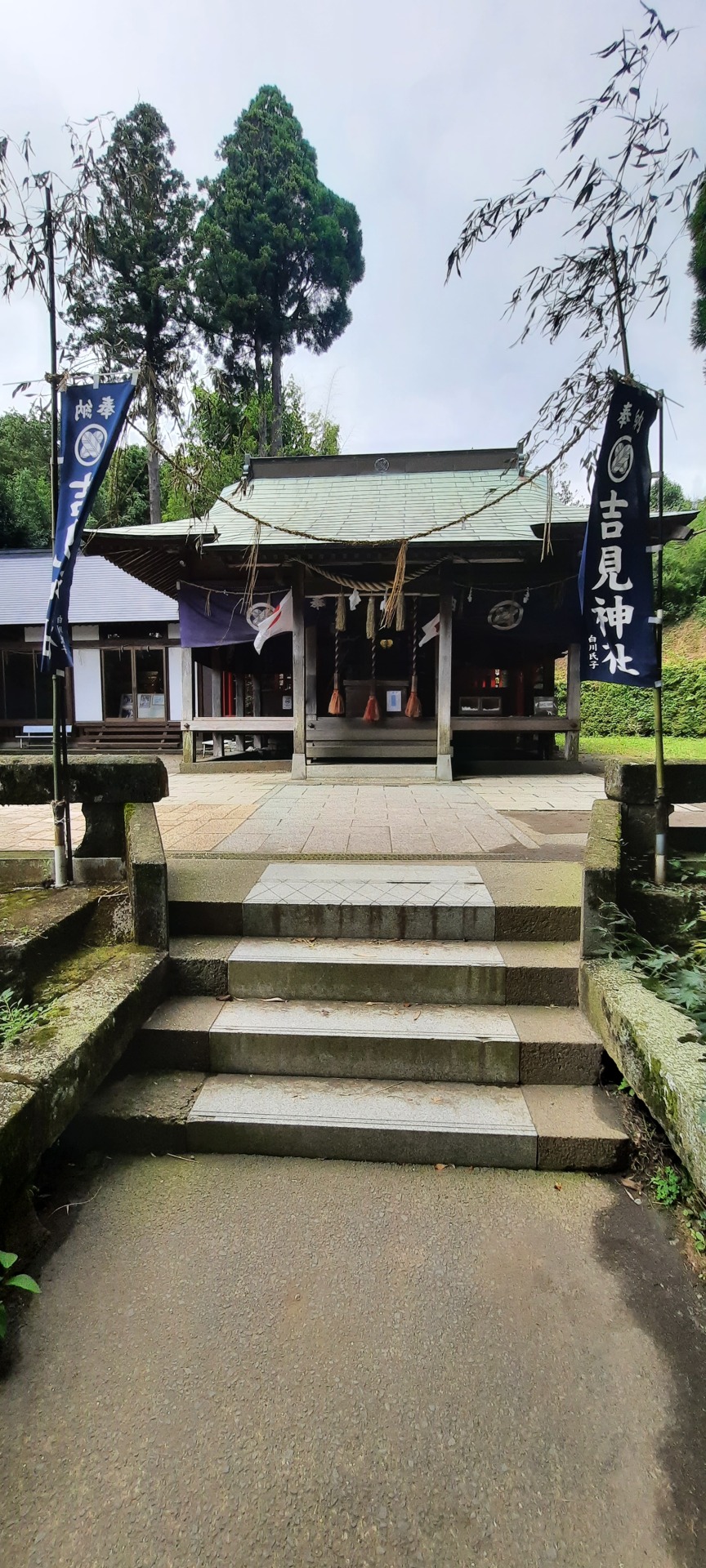
The white building to the left of the shrine is the shrine's mikoshi storehouse, mikoshi (神輿) being divine palanquins in which the gods' spirits are housed during festival parades.
Below: A glimpse of the palanquins as seen from outside.

Next, I went to the right of the prayer hall, and took the following side-shot of the shrine building. Here we can get a glimpse of its main hall too, where the gods are housed.
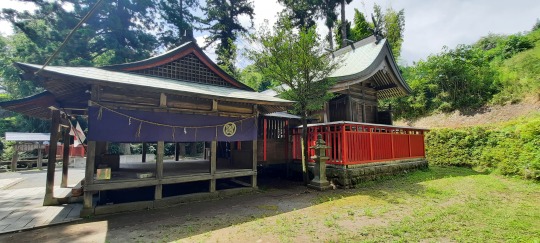
Opposite the main hall, on the right, is a smaller subsidiary shrine also under the management of the Shirakawa Yoshimi Shrine.
This one is simply classified as a keidai-sha (境内社 lit. "shrine within [shrine] grounds"). It used to be that these subsidiary shrines are divided into two types:
Sessha (摂社), colloquially called "auxiliary shrines", where gods related to the main shrine's gods are enshrined; and
Massha (末社), "undershrines", where unrelated gods are enshrined.
It used to be that auxiliary shrines are at a higher rank than undershrines, but this class system has now been discarded, any some shrines no longer list out which these subsidiary shrines used to be. This is one of them.
This particular shrine is a combination of three, first among which is a Tenman-guu Shrine (天満宮 lit. "Palace of Tenman"), which enshrines the famous scholar god Sugawara no Michizane, or Tenman Tenjin (天満天神).
Below: The subsidiary Tanman-guu Shrine.

Alongside the great Tenjin, two deities long since worshipped by local villagers are now also enshrined here, they are two particular aspects of the bodhisattva Kanzeon (観世音): Safe-childbirth Kanzeon (子安観世音) and Horse-headed Kanzeon (馬頭観世音).
Below: The statues of Tenjin, Safe-childbirth Kanzeon and Horse-headed Kanzeon (in order), enshrined within the Tenman-guu Shrine. From this shrine-themed website.



Safe-childbirth Kanzeon is said to impart, as the name suggests, safe childbirth; While the Horse-headed Kanzeon (who funnily enough doesn't have a horse head here) is said to protect travellers.
Combined with the scholar god Tenjin, this is a surprisingly potent shrine, covering a good chunk of our early lives.
One might note that Kanzeon, perhaps more commonly known in her Chinese rendition as Guanyin, is not exactly a Shinto deity, but rather a Buddhist figure.
This should come as no surprise if we look at Shinto and Buddhism's history in Japan, where they were, for most of its history since the introduction of Buddhism, viewed as the same thing.
And thus it's actually not uncommon at all for Buddhist features to be found in Shinto shrines, nor vice versa. That's all I'll say here, so as not to derail things, though if any of y'all are interested I could certainly write on that as well.
In any case, that's the entirely of the shrine explored, and we head off to our next destination.
History
Now that our tour is over, we can move onto the history of the shrine.
This shrine, being a comparatively larger scale shrine, has a clearer history than the last one, well-kept by the shrine's records. So, here's the Shirakawa Yoshimi Shrine's history, as told by the shrine itself.
Below: The sign on which the shrine's history can be found.
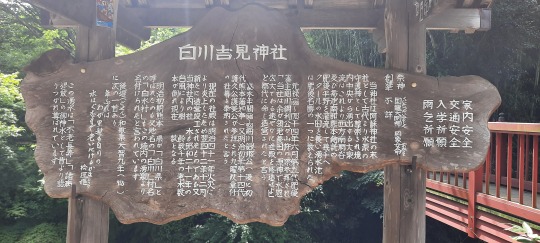
Official Shrine History
Year of Establishment: Unclear
Since ancient times, this shrine's has been considered the protector shrine of the Shirakawa Spring as the undershrine of the Aso Shrine (阿蘇神社).
The great spring gushing out from the center of the shrine is considered one of the greatest views of Higo (肥後 the historical province the Aso region is found in).
Its water flows through the Nangou Valley (南郷谷) to the west, then through southern Kikuchi (菊池) to finally supply water to the several thousand hectares of water paddies in the Higo plains (肥後平野) in Houtaku, Kumano.
In the 6th month of Genroku 14 (1693), the 5th lord (藩主 hanshuu) of Higo, Lord Tsunatoshi Hosokawa (細川綱利), visited this shrine when out hunting on the mountains.
He declared to the district administrator (郡代 gundai), "This shrine is where the spring god who supplies the fields in my land resides, and my gratitude for their grace is great indeed. With haste, build a shrine building here." Thus was the origin of this shrine.
It is said that the shrine curtains featuring the Kuyou (九曜 lit. "nine stars") emblem were offered up by Lord Yoshikuni Hosokawa (細川韶邦) (future first han-chiji of Kumano) during one of his visits, during the Kaei era (1848—1853).
Alternatively, it is said that it was offered up by the 14 generation's Lord Morihisa (護久) and Lord Moriyoshi (護美) during one of their visits, during the first year of the Meiji era (1868).
The current shrine building was built and completed in December of Meiji 42, as the previous building had burnt down in a fire a year prior, in Meiji 41 (1908).
Also, several old trees of several thousand-years old fell during a typhoon in Shōwa 21 (1946), reducing the number of shrine trees to what you see now.
It's said that the shrine's spring is why the Kumano prefecture was called the "Shirakawa Prefecture" during the early Meiji era, why the local region is called "Shirakawa" and also gave its name to Shirakawa Village.
The Later Collection of Japanese Poems (後撰和歌集), compiled in Tenryaku 5 (951), contains the following poem:
Many years have passed,
my black hair too, seems to have gotten old.
Just as how I now draw water from the Shirakawa.
— Higaki no Ouna (檜垣嫗)
The spring water has long been spoken of respectfully as divine water that grants "longevity without ageing" and "dispersal of current illnesses".
Overall History
And that's everything that's written on that sign! There's a bit more to go though, expanding on what the shrine's own records along with other records tell us.
To start with, we're actually going back to that poem by Higaki no Ouna. If it is true that the name Shirakawa came from the shrine, this would mean that it needs to be at least as old as the Later Collection of Japanese Poems, in which the poem is found.
Higaki no Ouna's Poem
A bit of context for the poem, Higaki no Ouna is poet said to have been a prostitute known for her refinement.
This poem is said to have been composed by her as she was fetching water from the Shirakawa river, lamenting how she had fallen into ruin with old age, having to fetch water herself rather than being able to have someone else do it for her.
Here both "Shirakawa" and the phrase "draw water" are kakekotoba (掛詞), or "pivot words", a technique used in Japanese waka poetry where kanji carry two layers of meaning, one literally from the kanji and one from its reading.
Yes it's basically a pun, in a sense. But it's elegance comes in how it allows the poet to use less syllables in the poems, while at the same time expressing more. This brevity is considered key in these poems.
The two here respectively point to "white hair" and "teeth that emerge as one becomes old", both pointing to how old Higaki no Ouna now is.
The collection was compiled in 951. means that the shrine has to have existed in some capacity by the late Heian period (794—1185).
However, according to the Aso Shrine's records, the undershrine mentioned in the shrine's records was not establiished until the end of the Tenshou era (天正), around 1573 to 1593.
Thus it is thought that this place had been home to a water god faith even prior to its establishment as an undershrine of the Aso Shrine.
Whatever the case, during its time as an undershrine, its resident water god was Himemiko-no-Kami (比咩御子神), the goddess of the 3rd palace of the Aso Shrine.
The next notable part of the shrine's history is with Tsunatoshi Hosokawa, you might notice that the above sign makes it sound like he ordered for a shrine to be built where a shrine already existed.
It's not exactly clear what the passage means by this, though it could mean that it didn't have a proper shrine building before this.
Skipping ahead, it is in the 1st year of Meiji that the shrine gets to its current form. It was re-assigned as a Yoshimi Shrine (吉見社) during this period, replacing its old head shrine of the Aso Shrine with the Kusakabe Yoshimi Shrine (草部吉見神社).
Alongside this change, the Shirakawa Yoshimi Shrine adopted the Kusakabe Yoshimi Shrine's head god, Kunitatsu-daimyoujin (国龍大明神), and changed its water god to be Mitsuhanome-no-Mikoto (罔象女命).
Mythology
The mythology of this shrine isn't going to be as interesting as the last one, since there's no particular tale behind the shrine or the spring's origins.
So instead, let's briefly go over the shrine's main blessings, as well as the various gods it's once enshrined.
Blessings
According to the sign above, the shrine has 2 main blessings: Safety at home and Safety in traffic;
Additionally, it's also known to be particularly responsive to two types of prayers: That for school admissions and rain.
Gods
As mentioned in the history section, the Shirakawa Yoshimi Shrine likely had three generations of gods, starting with an theorised water god before formal shrine worship, though there's nothing much to really say about this one, so we can move on to generation 2.
Next the shrine was formally established as an undershrine of the Aso Shrine. The Aso Shrine's head god is Takeiwatatsu-no-Mikoto (健磐龍命), grandson of legendary 1st Emperor Jimmu.
You might recognise this to be the very same Aso-daimyoujin (阿蘇大明神) mentioned last time. We are in the Aso region after all, it only makes sense that the "great shining god of Aso" take central stage.
The Aso Shrine is mainly divided into twelve "palaces", and Himemiko-no-Kami is the goddess of the fourth palace.
She is Takeiwatatsu's aunt, through marriage to his uncle, and was taken to be the the Shirakawa Yoshimi Shrine's water goddess while it was under the Aso Shrine's jurisdiction.
The shrine was later reclassified to be under the Kusakabe Yoshimi Shrine's lineage, which is actually not too surprising when you consider that this shrine's head god is Kunitatsu-no-Kami (国龍神 lit. "country dragon god"), Himemiko's husband.
Kunitatsu is perhaps more readily known outside of Aso as Hikoyai-no-Mikoto (日子八井命), Emperor Jimmu's eldest son.
At the Shirakawa Yoshimi Shrine, he is eulogistically titled the "Great shining god Kunitatsu" (国龍大明神 Kunitatsu-daimyoujin) and seems to have replaced his wife's role as water god of the spring.
This would likely be because he is worshipped as a water god at the Kusakabe Yoshimi Shrine, making him a better fit for this role than his wife, who doesn't seem to have any connection to water (though admittedly I couldn't find much on her to begin with).
Finally, it is also at this stage that Mitsuhanome-no-Mikoto (罔象女命) was added to the shrine's pantheon. She is famously the water goddess born out of a dying Izanami's urine, but not much else is known about her beyond this.
Still, a water goddess is a water goddess, so she fits right in at the Shirakawa Yoshimi Shrine.
Ending
And that concludes my dive into the Shirakawa Yoshimi Shrine, this one's quite a bit more dry this time, perhaps due to the shrine having less of a colourful story, but it's still a wonderful place, so I hope you enjoyed all the same~!
#japan#japanese mythology#shinto shrine#shirakawa yoshimi shrine#you would not believe#how much time and research it took me#to understand that poem#I'm not remotely familiar with classical japanese after all lol#100% worth it though imo#my curiosity must be satisfied
6 notes
·
View notes
Text
Speaking of which… I would like to officially declare this my AO3 commenting catch-up week (/month).
3 notes
·
View notes